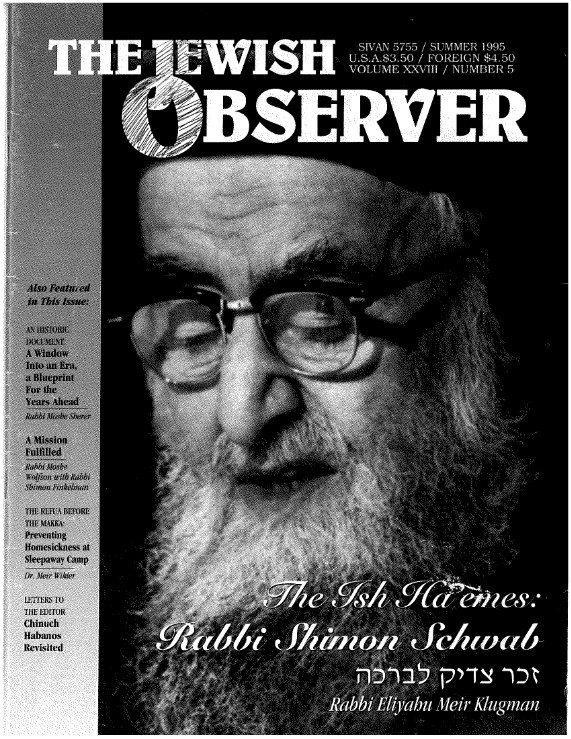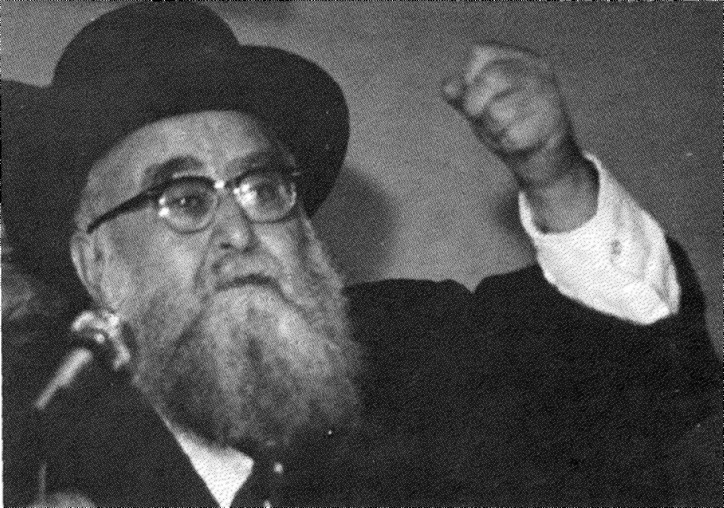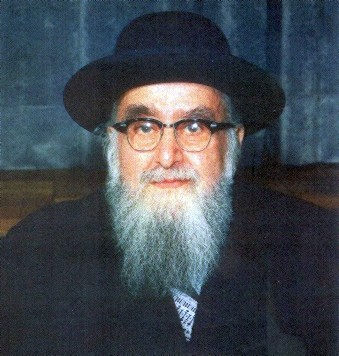
Another illustration with an important lesson for us as well, is recorded in Speeches (45). To most people it would have been an interesting experience but to the Rav it taught how anyone can do teshuva.
Briefly, he was called to the bed of a man dying of tuberculosis. He writes,
"When we were alone he began telling me his life story. He had come from a religious family in Vienna. Nevertheless, he gave up all religious ties and lived a life without any restraints. Then his son married a non-Jewish woman and he realized he had done wrong. Now here he was dying and he wanted to say Vidui. Then he started to scream. Then he spoke directly to Hashem, `I was the greatest sinner! I wasted my life! How can I appear before You?' It was so heart-rending. Whenever I remember it, I start to tremble."
He told the man he could see him again tomorrow — which he did at the man's funeral. His lesson was, "Through this man, I could see what is the power of teshuva. We say in Ne'iloh, `ad yom moso techake lo — You wait until the day of his death.' "
Just like one could always learn lessons from the mundane, one could also teach from them.
A father once came to visit with his son. Rav Schwab asked the boy what gemora he was learning. When the boy replied he was learning Hameini'ach (3rd perek of Bava Kama) Rav Schwab asked the boy: what's a "kad" and what's a "chovis."
After the boy answered everything successfully, Rav Schwab threw him with the question, "Who made the kad?" The boy was amazed because that's not discussed in the gemora. Then Rav Schwab asked him, "And who made the chovis?"
When the boy still wouldn't answer, Rav Schwab proceeded with the lesson. A Jewish worker! He told the boy you see we need Jewish artisans — we need Torah Im Derech Eretz just like we need Torah only. Thus, out of nowhere came a lesson in hashkofo.
We saw his pikchus before in how he educated his own children. Another educational example is in giving tochocho. He once met a man who seemed to have a cut on his face. The Rav inquired what had happened. The man related that he cut his face with his razor. The Rav didn't say a word of reproach. Instead he went and obtained a shaver for the man. He gave it to the man with the explanation that he thought the reason the man used a razor is that he couldn't buy a shaver since as Jews we're enjoined from using a razor. He thought this would be a much more effective means of tochocho.

One final example of pikchus which is of biographical significance in itself. I once asked a close associate of Rav Schwab, "What could you say Rav Schwab's main accomplishment was in Washington Heights?"
After all, the situation was quite different than in Baltimore. In Washington Heights there was an established, frum kehilla set up by Rav Breuer zt'l. There was a yeshiva, kashrus was strictly observed, no problems of mechitza, chilul Shabbos, in short, all that Rav Schwab had to fight for in Baltimore awaited him in Washington Heights thanks to Rav Breuer.
The person explained that what Rav Schwab did for Washington Heights was basically a reflection of what he done to himself. Rav Schwab came from Germany but then synthesized this with the Yeshiva world he had encountered in Eastern Europe and the American lifestyle he had met in Baltimore.
So it was in Washington Heights, the community had made great strides but Rav Schwab transformed the kehilla from a German transplant into one which, while it strictly adhered to German minhagim and the hashkofo of Reb Shimshon Raphael Hirsch, it nonetheless had respect in the Torah world as well. It opened a kollel, a seminary, a separate high school. English also replaced German as the language used for communication under Rav Schwab, to mention just a few examples.
Having witnessed some of the battles, I expressed my surprise at this assessment. I had known that other people were on the front lines of many of these struggles, and here he's giving a major share of the credit to Rav Schwab.
His reply was that whereas others fought valiantly, they often were not successful. Rav Schwab would win the battle by fighting quietly, slowly but painstakingly. In fact, this person had raised many of these issues in a discussion with Rav Schwab at the outset of the latter's career in Washington Heights. Rav Schwab at that time reassured him, "Eventually we will be'ezras Hashem, accomplish everything but it will take time."
In retrospect, this person said, Rav Schwab left the world having achieved everything they had discussed some thirty-five years earlier. That is what it says, "Betachbulos ya'aseh milchomo" — successful strategies win wars. On the surface one wouldn't even know a battle was being waged but there it was, slow and steady. Rav Schwab may have learned this lesson from Rav Hirsch's twenty-five year battle for Austritt.

Hating Sheker
Finally, we should be choseim with the chosemes of HaKodosh Boruch Hu: emes. We mentioned earlier Rav Schwab's affection for sincere people and the great koach he ascribed to lishmo. These are just two facets of the midda of emes: if one is sincere, if one does something lishmo and for no ulterior motive, then his action is done be'emes it truly represents him.
Nothing could better describe Rav Schwab's attitude towards sheker than the words of Dovid Hamelech (Tehillim 119, 163) Sheker soneisi vo'eso'eivo — I hate and abhor falsehood.
His whole life he preached and fought for emes, for honesty. We must be honest with ourselves; is our lesheim Shomayim, lesheim Shomayim? We must be honest with others, Jews and non-Jews.
One illustration of his hate for the slightest sheker can be seen from the following episode.
When his last English sefer, Selected Essays, was published, the sefer was brought to Rav Schwab. He was delighted and immediately made a brocho — Hatov veHameitiv. (His making this brocho is something of a chidush — cf. for example, the introduction to the Minchas Yitzchok.) He then started leafing through the book and noticed that the jacket contained a statement saying that he had served together with Rav Yosef Breuer in Frankfurt.
At this, his happiness turned into sorrow. He exclaimed that it is a sheker, then ripped the jacket off and tore it up. He was doubly upset, since he said he had also made a brocho levatolo. He called the publisher and told him he may not distribute the sefer with the jacket until new jackets were produced. They had already shipped some to be sold at the Aguda convention, but even those had to be called back to take off the jackets. All this for what would seem just a minor mistake — but to someone dedicated to fight sheker with all his might, this was a very serious infraction.
If, to Rav Schwab, an honest person was to be respected, he had even more respect for an honest talmid chochom. There could be nothing greater.
Once, when he could barely stand, his family noticed him standing up while talking on the phone for a few minutes. They were amazed! He could hardly stand at all and here was talking on the phone standing up. When his conversation was finally concluded they asked him about it. He told them that he had been speaking with Reb Moshe Feinstein zt'l and, although one needn't stand up when talking on the phone, but, he said, "How could I not stand?"
We mentioned earlier that Rav Schwab referred to the posuk, "Ho'emes vehasholom ehovu," as Rav S. R. Hirsch's leitmotif.
Rav Schwab gives his interpretation of the posuk in his own peirush on Chumash (Shemos 4, 14). He notes that "emes" comes first. We should strive for both emes and sholom, but there are situations when there is a clash. Rav Schwab explains that then the posuk enjoins us to take up the cause of emes and relinquish sholom (in the short term at least).
He uses this idea to answer the Ramban's objection to the Rambam's claim that the term "charon af" is only used in reference to avoda zorah. Ramban asks that when Hashem was "choro apo" on Moshe Rabbenu no avoda zorah was involved.
Rav Schwab answers that Aharon got his position as kohein for Klal Yisroel as a result of Hashem's charon af on Moshe at this instance, as Rashi remarks. Later, Aharon's desire for sholom allowed him to give priority to sholom in the case of the eigel hazohov. Thus the charon af here is consistent with the Rambam's principle since avoda zorah eventually ensued.
On a personal level he strove towards exemplary behavior. An example can be seen from the fact that when he sold his house in Baltimore, the government tax official representative commented that he never saw some one fill out a tax form so scrupulously. As we will see, he considered this to be not only Kiddush Hashem but the meaning of bitochon as well.
A rav once called with a sha'alo. The rav told Rav Schwab that a frum acquaintance of his did much business on a "cash" basis (i.e. unreported). The tax authorities had gotten wind of this and they subpoenaed the records of a lady who regularly did business with this person. The question of the rav was whether the woman could deliver up her checkbooks to the authorities or was it a problem of being a moser?
Rav Schwab asked the questioner (the rav) to repeat the question. He did this about four times. Finally the exasperated rav asked Rav Schwab, "What do you want from me?"
Rav Schwab replied, "Listen to what you say, you call this man a `frum' Yid? Someone who is negligent in Choshen Mishpat can be called a `frum' Yid?"
He felt that even if someone was otherwise frum, if he would be dishonest even when dealing with the government that was a contradiction and he was not a true frum Jew at all.
Money and Bitochon
He maintained that cheating in business shows a complete lack of bitochon. He explains (Speeches 124) that, "Both Jews and non-Jews should be so impressed by a baal bitochon's bearing and impeccable behavior that they will be stirred to praise the G-d who inspired such behavior."
One more illustration of the chashivus of emes. He knew a frum person who owned a small store. Every Friday afternoon this man would release all the Jewish workers for Shabbos, but the business stayed open. The proprietor claimed he had a goyishe partner (cf. Orach Chaim 245) but Rav Schwab convinced him it would be proper to close the store for Shabbos nonetheless.
A while later the man sold the store at a sizable profit. However, he then proceeded to lose all the money and, since he couldn't raise money, he was forced to declare bankruptcy. A while later he opened a new business which he ran in a very honest manner, and he was very successful.
One day the Rav asked him if he had paid back all his creditors in full. The man replied that under the terms of his bankruptcy his creditors had agreed that he pay twenty cents on each dollar of debt. Rav Schwab protested that bankruptcy has no halachic standing and as such he remained obligated to pay the remaining eighty percent. He convinced the man of this and when he paid all his creditors in full a great kiddush Hashem ensued.
A final quote from Speeches (66) encapsulates his feeling about cheating, trickery, dishonesty and fraud — gezel, sheker and ona'ah — while they sometimes may have the outward appearance of being G-d-fearing Jews, in fact they are irreligious. They lack emunah for they do not believe that G-d `feeds and provides for all.' They may well be strict in their observance of certain mitzvos, but in their business dealings they reveal that they are kofrim in hashgacha protis. They certainly do not believe that G-d wants them to lie, cheat and take what is not rightfully theirs so as to obtain their sustenance... What they are actually doing, then, is conducting their business as though He does not exist, cholila."
Learning from the Life and Life's Work of Tzadikim
Rav Schwab's neshomo has gone to its mokom hagonuz — to the place he prepared while he was alive. Just like the Ramban explains about nissim geluyim: Hashem performs them only at special times and it is our duty to perpetuate them by remembering and reliving them. It is the same with tzadikim. Hashem showed them all to Adam, but he "planted" them in the different generations. The dor of the Chofetz Chaim needed and was zoche to have the Chofetz Chaim. We perpetuate his memory by learning his seforim, emulating him and striving for his ideals.
Similarly our dor was zoche to have a yer'ei Shomayim, a mechanech like Rav Schwab. It says in Parshas Eikev (11, 2-7) that you should know that I'm not speaking to your children who didn't know and didn't see the mussar of Hashem... but to you whose eyes have seen the great deeds of Hashem.
We can deduce that even though it is incumbent upon all generations to learn from Hashem's miracles nonetheless the obligation is greatest on those who were witness to their occurrence. Similarly we are obliged to learn from all tzadikim but even more so a tzaddik who lived in our midst, whom we saw and heard. If we do this then we can truly say "Greater are tzadikim in their death more than when they were alive."




